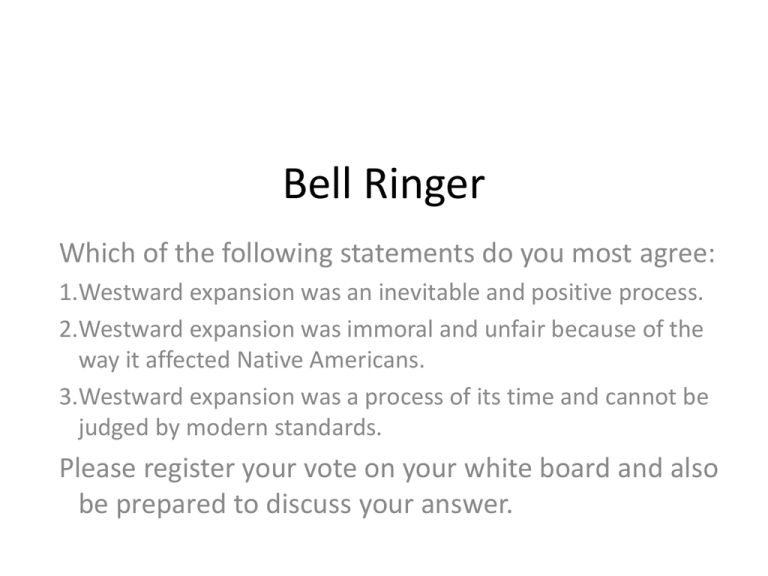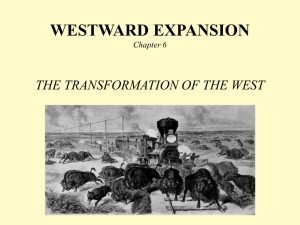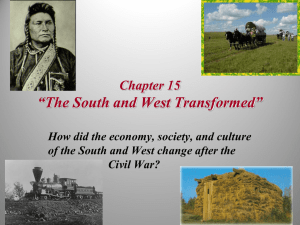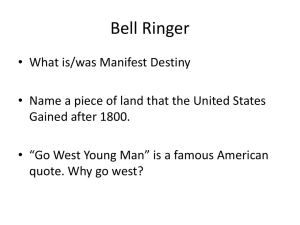The South And West Transformed
advertisement

Bell Ringer Which of the following statements do you most agree: 1.Westward expansion was an inevitable and positive process. 2.Westward expansion was immoral and unfair because of the way it affected Native Americans. 3.Westward expansion was a process of its time and cannot be judged by modern standards. Please register your vote on your white board and also be prepared to discuss your answer. The South And West Transformed Chapter 6 Weekly Standards • B.3. e. Analyze the immediate and long-term influences of Reconstruction on the lives of African Americans and U.S. society as a whole • C.1.f. Compare and contrast the experiences of African Americans in various U.S. regions in the late 19th century • C.1.g. Identify and evaluate the influences on the development of the American West • C.1.h. Analyze significant events for Native American Indian tribes, and their responses to those events, in the late 19th century The New South Industries and Cities Grow Main Idea: In the 1880s, new industries spread throughout the south. As cigar and lumber production increased, along with the growth of coal-, iron-, and steel-processing centers, new cities emerged in the Carolinas, Georgia, Virginia, Tennessee, and Alabama. Southern Farmers Face Hard Times Main Idea: Before the Civil War, most southern planters had concentrated on such crops as cotton and tobacco, which were grown not to be sold for cash. The lure of the cash crop continued after the war, despite efforts to diversify. The South’s heavy reliance on these cash crops made them vulnerable when pests threatened their crops. Black Southerners Gain and Lose Main Idea: The Thirteenth, Fourteenth, and Fifteenth amendments had changed African Americans’ legal status. Over time, however, these legal gains were pushed back by a series of Supreme Court decisions. The New South • Industries and Cities Grow – Northern money produced textile mills, cigar and lumber production – Cities sprung up around steel, coal, and iron processing plants – Smaller farms took place of large plantations – Railroads – needed to continue industrialization • Connected rural to urban hubs – only 2 went North to South – Southern economic recovery limited • • • • Had to recover from war South had little capital Unskilled labor – poor education – low wages Weak banking system – who had money to invest? The New South The New South • What factors limited southern economic recovery? 1. Lack of workers and investment capital 2. Poor conditions after the Civil War 3. Railroads only connecting in 2 southern areas TRANSPARENCY Railroads Connect the South The New South • Southern Farmers Face Hard Times – Cash Crop – cotton & tobacco = $$$ – Too much cotton causes the price to _____________ DROP – Farmers band together – Farmers alliance • Tried – force railroads to lower rates • Government regulates pricing - price = distance – African American Gains • 13th, 14th, 15th, military, businesses, education, new colleges, Civil Right Act 1875 – guaranteed use of public facilities – African American Losses • Segregation, violence, Court decisions reversed CRA-1875 – owners could choose who they served CHART Wholesale Price of Cotton, 1865-1890 The New South Why did southern farmers face hard times? When cotton prices because of a lack of buyers and the boll weevil infestation, southern farmers, whose main crop was cotton suffered How did southern blacks lose their rights? Some whites wanted to reverse the gains African Americans had made during reconstruction by segregating churches and passing laws that supported the elimination of black officials. Also, the Supreme Court made decisions that allowed segregation on the local level Westward Expansion and the American Indians Cultures Under Pressure Main Idea: By the end of the Civil War, about 250,000 Indians lived in the region west of the Mississippi River referred to as “The Great American Desert.” Although they were lumped together in the minds of most Americans as “Indians,” Native Americans embraced many different belief systems, languages, and ways of life. New Settlers and Native Americans Clash Main Idea: The rapid industrial development and expansion following the Civil War set Native Americans and white settlers on a collision course. The End of the Indian Wars Main Idea: The conditions facing Native Americans had all the ingredients for tragedy. Indians were confined to isolated and impoverished areas, which were regularly subject to disease. Frustration, particularly among young warriors, turned to violence. The Government Promotes Assimilation Main Idea: The reservation policy was a failure. Making Indians live in confined areas as wards of the government was costly in human and economic terms. Westward Expansion and the American Indians Cultures under pressure Though most Native American tribes had different ways of life they all believed they were one with nature and nature was sacred – white men did not feel the same way. Early 1800s Indians can have the west – desert uninhabitable 1830s trade regulation = limited white access to territory 1850s Gold & silver found in Indian territory 1851 railway wanted restrict Indians to smaller territory 1860s Indians forced onto reservations New diseases spread from white men White men killed Indians food for sport – left Indians struggling to survive Westward Expansion and the American Indians 1. What three circumstances hurt Native Americans? The forcing of Native Americans onto reservations; the introduction of diseases which Native Americans were not immune; the destruction of buffalo herds TRANSPARENCY Sand Creek Massacre Westward Expansion and the American Indians New Settlers & Native Americans Clash Sioux Indians resisted expulsion – attacked settlements in Minnesota Sand Creek Massacre – US troops massacre federally protected Cheyenne and Arapaho tribes residing at Sand Creek (unarmed) Plan for Peace Fails Indians must settle on farms & become civilized Fort Laramie Treaty – Sioux gained more land Land was not adequate, some Natives could not abide by the rules Westward Expansion and the American Indians 1. Why did tension exist between settlers and Indians? Settlers wanted the land and its resources, but Native Americans did not want to move. Treaties were made, but the government did not enforce them. Westward Expansion and the American Indians Apache & Navajo War (1861-66) Fetterman Massacre (1866) Red River War (1874-75) Battle of Little Big Horn (1876) – Sitting Bull Nez Perce` War (1877) – Chief Joseph Battle of Wounded Knee (1890) Please understand all of these battles (wars) between settlers and Indians Westward Expansion and the American Indians Government promotes assimilation Indians would become farmers and adapt white mans culture Assimilate – take on traits of others immediately Why is forced assimilation destined to fail? This entails major psychological changes and often severing of emotional ties with one’s background and family. Most cases this causes a person to no longer belong to their old culture or their new one, leaving them with no future. Can cause severely violent reactions Dawes General Allotment Act Replaced reservation system and gave Indians 160 acre lots to KEEP for 25 years. Worked fine in the east, but was not enough to supply a family in the west. More assimilation – schools - learn our culture INFOGRAPHIC Assimilation by Force Infographic: Assimilation by Force Westward Expansion and the American Indians 1. How did the Dawes Act change the way Indians were treated? Native American families were granted land, and it was protected for 25 years in hopes that younger generations would take up farming to go along with their knowledge of their new culture. Transforming the West Miners Hope to Strike It Rich Main Idea: Mining was the first great boom in the West. Gold and silver were the magnets that attracted a vast number of people. Prospectors from the East were just a part of a flood that included people from all around the world. Railroaders Open the West Main Idea: As industry in the West grew, the need for a railroad to transport goods increased as well. The effects of the new railroads were far reaching. They tied the nation together, moved products and people across the continent, and spurred industrial development. Ranchers Build the Cattle Kingdom Main Idea: Cattle ranching fueled another western boom. This was sparked by the vast acres of grass suitable for feeding herds of cattle. Once the railroad provided the means to move meat to eastern markets, the race was on for land and water. Farmers Settle on Homesteads Main Idea: The Great Plains were the last part of the country to be heavily settled by whites. It was originally set aside for Indians because it was viewed as too dry for agriculture. Yet, with the coming of the transcontinental railroad, millions of farmers moved into the West. Continued… NOTE TAKING Reading Skill: Identify Main Ideas Transforming the West Miners hope to strike it rich Mining towns spring up over night Rules set up to settle disputes – vigilantes – administered justice Boomtowns to ghost towns when the gold ran out Mining goes from small time to big time Companies drill deep mines – extract gold using tracks – hire Mexicans and Chinese to work underground Railroads Open the West Transcontinental Railroad – not government owned Used land grants to fund Promontory Point Central Pacific headed east while the Union Pacific headed west, meet at Promontory Point, Utah Transforming the West Railroad Opens the West Workers – Irish, Chinese, Mexican, short supply, harsh conditions, DEATH Railroad changed the west – New towns and cities – you wanted your city close to the railroad; people bought up land that might get access to the railroad (Why?) Union begins to swell To become a part of the United States of America from 1864-1896 you had to meet the following requirement - You must have 60,000 inhabitants -10 new territories met this requirement Transforming the West Ranchers build the cattle kingdom (Yee-Haw) Railroad was used to move meat (food) Open-range system No fences, cattle grazed freely Stereotypical Cowboy emerges along with cattle drives (dangerous) Cow Town – Dodge City, Kansas Rise of legends: Wild Bill, Wyatt Earp, Doc Holiday, Jesse James Demise of the Open-Range Barbed wire invented Supply of beef exceed demand Extreme weather Transforming the West 1. What were the two major phases of mining? Individual miners worked surface soil or streambeds; big companies took over to mine deep underground 2. How did the government encourage the development of the Transcontinental Railroad? It provided money for construction and gave land grants to the railroad companies 3. How did the railroad affect the cattle industry? Railroads provided a way to ship beef. Ranchers had to use cattle drives to get cattle to railroad stations. Transforming the West The Great Plains Homestead Act provides anyone willing to live on, build a road, and dig a well, 160 acres of land African Americans (Exodusters) – took this chance in Kansas & Oklahoma Everyone had a job to do to provide for the family in the west Needs met? Barb wire, plow, windmill – all helped farmers succeed somewhat Morrill Act 1892 – establishment of Agricultural Colleges Competition, Conflict & Change How to use the west – led to violence Prejudice & Discrimination – not just black & white – ranchers vs. farmers. Only 20% of the population with 80% of the minorities By 1890 all of the US was inhabited closing the frontier Transforming the West 1. Why did farmers move to the Great Plains? To own land and for more space, freedom, and profit given to them through the Homestead Act 2. What were some of the causes of prejudice and discrimination in the West? The West only had 20% of the US population at the time, however 80% of the population in the West was a minority. Differences in language, food, culture, and religious practices reinforced each groups fear & distrust of one another. There were also cases of ranchers vying for the use of land that would be much different than the ideas of a farmer.









